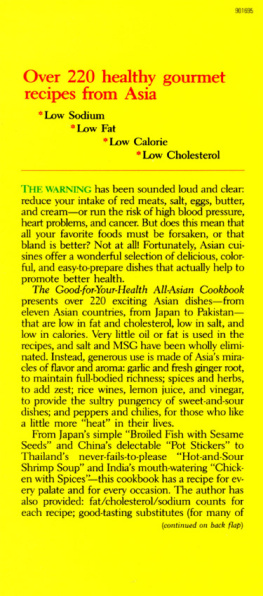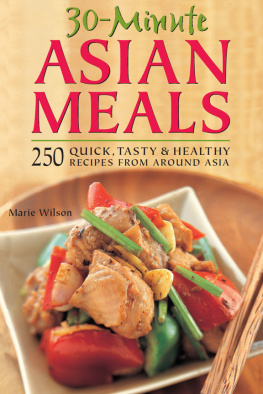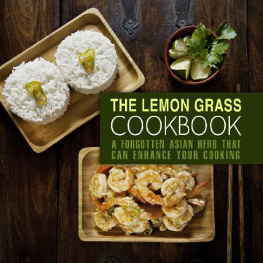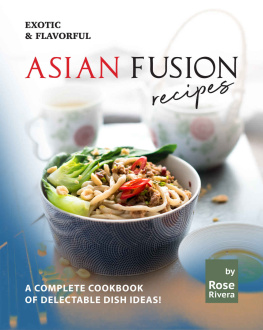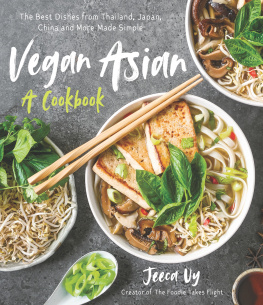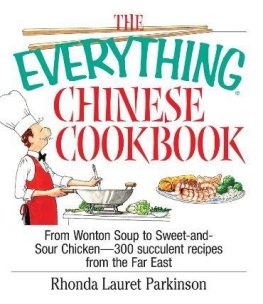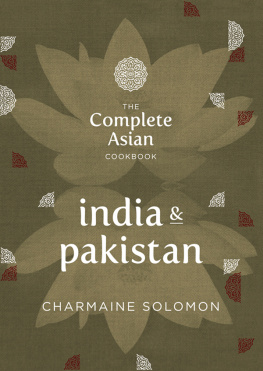Acknowledgments

I would like to acknowledge my indebtedness to the many writers and cooks who brought me closer to the cultures and cooking of Asia, and to those in the fields of health and medicine whose writings helped me to understand more fully the connection between diet and health. Reading their works started me on long and pleasurable journeys of experimentation, and without their help this book would not have been possible. Their names and works are listed in the bibliography.
I am also grateful to the University of California East Asiatic Library and the South/Southeast Asia Library in Berkeley, from whose collections the drawings for this book have been derived.
My special thanks also go to those who helped with the following chapters: China: Zhang Yaqi, an exchange teacher from Hunan Teachers University, who demonstrated to me that large quantities of soy sauce are not necessary to prepare good-tasting Chinese food; India: Amrita Sengupta; Indonesia: Tati Conomondo and Krishni Simanjuntak; Japan: Masayo Watanabe Wilson, my very dear daughter-in-law and friend; Korea: Clare You, who introduced me to Korean food and who gave so generously of her time; Pakistan: Naheed Aftab; and Vietnam: Chanh Nguyen. For professional advice about the nutrient analysis of foods, thanks to Carol Lynn Carr, R.D., Helen Black, R.D., Nan Moon, R.D., and to Teresa Chew, R.D., for the use of her work on Chinese condiments in sodium-restricted diets. Her article is also listed in the bibliography. Thanks are also due to Jack and Mary Murchio for advice on weights and measures and for the use of their art library, to Barbara Phillips for her editing skills, and to Stephen Comee for his. My thanks to him also for six of the recipes. I could not have been luckier. I am deeply grateful to all, but I alone am responsible for any mistakes.
Acknowledgment is also due to The Centre, a meeting place for families from all over the world who are visiting the United States as students and scholars at the University of California at Berkeley. They came together and generously shared their customs and foods.
My biggest debt is to my children, Elizabeth and Stephen, who spent a significant part of their formative years in Thailand and Japan, for their professional advice, gentle encouragement, and unflagging support. No words of thanks will ever be enough. As medical practitioners, talented cooks, and loving children, they both sustained me to a degree that only I can appreciate.
Appendixes
Fat'Cholesterol-Sodium Tables

Meat, poultry, fish, dairy products, fats, and oils provide the major sources of fats in the diet. The following tables (pp. 332-36) were compiled from the data used to calculate the nutrient analyses given at the end of the recipes in this book. All the figures have been rounded up to the nearest 5 or 10 mg, and to the nearest 0.5 g. In reading these figures, you will find a difference between the total fat and the sum of the values listed for individual fats. This is because there are other fatty acids that have not been included in the analysis. All of these nutrient values should be regarded fundamentally as estimates.
Also included is data on the sodium content of some Asian condiments, which have been based largely on the work of Teresa Chew. Most brands tested showed sizeable disparities from sample to sample, although sauces manufactured under Japanese brand names proved to be highly standardized. To my knowledge, no data is yet available on Southeast Asian pastes and fish sauces.
Disparities notwithstanding, these figures should prove useful as a tool in comparing one food with another, thereby showing in a relative sense which foods are low and which are high in fat, cholesterol, and sodium.

| Table 1 |
| Meat, Poultry, Fish, Tofu (uncooked, boneless, no skin or fat) | Unit | Calories | Total Fat (g) |
Chicken, white meat | 1 oz | | 1.4 |
Chicken, dark meat | 1 oz | | 1.8 |
Chicken liver, cooked | 1 whole | | 1.1 |
Beef, lean | 1 oz | | 2.7 |
Lamb, lean | 1 oz | | 2.0 |
Pork, lean | 1 oz | | 3.9 |
Fish, lean | 1 oz | | 0.3 |
Fish, fatty (e.g. salmon) | 1 oz | | 1.6 |
Shrimp | 1 oz | | 0.35 |
Soybean curd (tofu) | 1 oz | | 1.25 |
Dairy Products |
Milk, whole | 1 cup | | 8.2 |
Milk, low-fat | 1 cup | | 2.6 |
Milk, nonfat (skimmed) | 1 cup | | 0.4 |
Yogurt, plain, low-fat | 1 cup | | 3.5 |
Buttermilk, low-fat | 1 cup | | 2.2 |
Egg, whole: fresh, medium | | | 5.6 |
Egg white | | | Trace |
Egg yolk | | | 5.6 |
Butter | 1 Tbsp | | 12.3 |
Fats and Oils |
Polyunsaturated oils |
Corn oil | 1 Tbsp | | 13.6 |
Safflower oil | 1 Tbsp | | 13.6 |
Sesame oil | 1 Tbsp | | 13.6 |
Soybean oil | 1 Tbsp | | 13.6 |
Monounsaturated oils |
Olive oil | 1 Tbsp | | 13.5 |
Peanut oil | 1 Tbsp | | 13.5 |
Saturated oils |
Coconut oil | 1 Tbsp | | 13.6 |
Nuts and Seeds |
Coconut, shredded | 1 cup | | 28.2 |
Sesame seeds: dry, hulled | 1 Tbsp | | 4.4 |
A dash () indicates data not available. |
Abbreviations used in this table are: oz=ounce; Tbsp=tablespoon; tsp=teaspoon. |
Sources for this information listed on page 335. |
| Fat-Cholesterol-Sodium Table |
Saturated
Fat (g) | Monounsaturated
Fat (g) | Polyunsaturated
Fat (g) | Cholesterol
(mg) | Sodium
(mg) |
| 0.4 | 0.7 | 0.3 | | |
| 0.5 | 0.6 | 0.4 | | |
| 0.4 | 0.3 | 0.2 | | |
| 1.23 | 1.1 | 0.1 | | |
| 0.9 | 0.8 | 0.1 | | |
| 1.6 | 2.1 | 0.5 | | |
| 0.02 | 0.01 | 0.06 | | |
| 0.5 | 0.8 | 0.1 | | |
| 0.05 | 0.05 | 0.15 | | |
| 0.2 | 0.25 | 0.65 | | |
| 5.1 |

